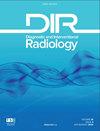Assessment of the compliance with minimum acceptable technical parameters proposed by PI-RADS v2 guidelines in multiparametric prostate MRI acquisition in tertiary referral hospitals in the Republic of Turkey.
IF 1.7
4区 医学
Q2 Medicine
引用次数: 6
Abstract
PURPOSE Although the clinical use of multiparametric prostate magnetic resonance imaging (mpMRI) is increasing, the adherence to parameters for mpMRI which had been described in the Prostate Imaging-Reporting and Data System version 2 (PI-RADSv2) for an optimum image acquisition is unknown. In this paper, we aimed to determine the compliance with the minimum acceptable technical parameters for prostate mpMRI defined by PI-RADSv2 in tertiary care centers in Turkey. METHODS We sent a survey to all radiology departments of tertiary referral hospitals in Turkey (n = 120) to evaluate their adherence to PI-RADSv2 technical specifications. Statistical analysis was performed using Chi-square, Fisher Exact, ANOVA, and the Student`s t tests. The cut-off values for image acquisition times were also determined with ROC analysis. P - values <0.05 were considered statistically significant. RESULTS One hundred and eleven clinics responded to our survey (response rate = 92.5%). Prostate MRI was reported to be performed in 61 centers. 26 (42.6%) centers used 3 T (Tesla) scanner while 1.5T was used in 35 (57.4%) centers. The adherence to slice thickness (ST), in-plane phase and frequency resolutions on T2WI were 68.9%, 41% and 9.8% respectively. The adherence to the same parameters on DWI were higher compared to T2WI (85.2%, 62.3% and 78.7%, respectively). In comparative analysis, the adherence to ST, field of view (FOV) and in-plane phase resolution on T2WI were higher for 3T compared with 1.5T scanners (P = 0.004, P = 0.041 and P = 0.001, respectively). T2WI acquisition time was significantly longer for the centers adhered to T2WI-FOV (P = 0.034) and in-plane T2WI phase resolution (P = 0.028). The DWI scan time was significantly longer when they adhered to DWI-FOV (P = 0.014) and b-value≥1400s/mm2 (P = 0.008). The calculated cut-off values were 220 seconds in T2WI and 312 seconds in DWI to ensure the compliance with voxel sizes and b-value criterias. CONCLUSION The tertiary referral centers in Turkey did not meet most of the technical specifications of PI-RADSv2 during prostate MRI acquisition. Awareness to the minimum acceptable technical parameters of mpMRI should be increased to potentially improve the quality of prostate cancer imaging.土耳其共和国三级转诊医院多参数前列腺MRI采集中PI-RADS v2指南提出的最低可接受技术参数的符合性评估。
目的尽管多参数前列腺磁共振成像(mpMRI)的临床应用正在增加,但对mpMRI参数的遵守情况尚不清楚,该参数已在前列腺成像报告和数据系统第2版(PI-RADSv2)中描述,用于最佳图像采集。在本文中,我们旨在确定土耳其三级护理中心是否符合PI-RADSv2定义的前列腺mpMRI最低可接受技术参数。我们向土耳其三级转诊医院的所有放射科(n=120)发送了一份调查,以评估他们对PI-RADSv2技术规范的遵守情况。采用卡方检验、Fisher精确检验、方差分析和Student t检验进行统计分析。图像采集时间的截止值也通过ROC分析确定。P值<0.05被认为具有统计学意义。结果111家诊所对我们的调查做出了回应(回应率=92.5%)。据报道,61个中心进行了前列腺MRI检查。26个(42.6%)中心使用3T(特斯拉)扫描仪,35个(57.4%)中心使用1.5T扫描仪。T2WI对层厚(ST)、平面内相位和频率分辨率的粘附率分别为68.9%、41%和9.8%。DWI对相同参数的依从性高于T2WI(分别为85.2%、62.3%和78.7%)。在比较分析中,与1.5T扫描仪相比,3T扫描仪在T2WI上对ST段、视野(FOV)和平面内相位分辨率的依从性更高(分别为P=0.004、P=0.041和P=0.001)。坚持T2WI-FOV(P=0.034)和平面内T2WI相位分辨率(P=0.028)的中心的T2WI采集时间明显较长。坚持DWI-FOV(P=0.014)和b值≥1400s/mm2(P=0.008)的中心DWI扫描时间明显较长,计算出的T2WI截止值为220秒,DWI截止值为312秒,以确保符合体素大小和b值criteria。结论土耳其的三级转诊中心在前列腺MRI采集过程中不符合PI-RADSv2的大部分技术规范。应提高对mpMRI最低可接受技术参数的认识,以潜在地提高前列腺癌症成像的质量。
本文章由计算机程序翻译,如有差异,请以英文原文为准。
求助全文
约1分钟内获得全文
求助全文
来源期刊
CiteScore
3.50
自引率
4.80%
发文量
69
审稿时长
6-12 weeks
期刊介绍:
Diagnostic and Interventional Radiology (Diagn Interv Radiol) is the open access, online-only official publication of Turkish Society of Radiology. It is published bimonthly and the journal’s publication language is English.
The journal is a medium for original articles, reviews, pictorial essays, technical notes related to all fields of diagnostic and interventional radiology.

 求助内容:
求助内容: 应助结果提醒方式:
应助结果提醒方式:


